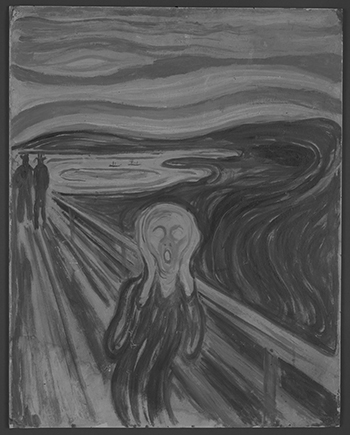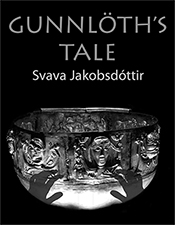Modernism in the Nordic countries
As elsewhere, modernism was a movement concerning the profound questioning of traditional values, modes of speaking and interpretations of subjectivity. A mass of Nordic literature was produced that could be said to be modernist, from Norwegian Knut Hamsun’s innovative novels in the 1890s, to the influential high Swedish modernism in poetry led by Erik Lindegren and Karl Vennberg, to stream-of-consciousness prose by Icelandic Svava Jakobsdóttir, to name but a few.

Modernism is an aesthetic concept referring both to a literary form and an attitude towards conditions in life and society. Scholars of Nordic literature share the understanding that modernism as a canonised norm made its breakthrough during the Second World War. Although this début came later than in other European countries, the Nordic countries had had widely known forerunners of modernism in the second half of the nineteenth century, including Knut Hamsun and Sigbjørn Obstfelder in Norway, August Strindberg and Selma Lagerlöf in Sweden, Sophus Claussen in Denmark. In the Finland-Swedish poetry of the 1910s and 1920s, Edith Södergran, Elmer Diktonius, and Gunnar Björling were forerunners of the movement.
Modernism can be seen as an aesthetic response to processes of modernity, e.g. socio-historical developments such as industrialisation, increased mobility and urbanisation; technological advances with regard to communication systems and infrastructure; and new ideas such as Darwinism, Marxism, psychoanalysis and the women’s liberation. Modernity is not, however, a topic, but rather a profound questioning of traditional values, modes of speaking and various interpretations of subjectivity. While it does not produce unambiguous answers, modernism radicalises the manner in which questions are posed, as well as addressing the crisis of representation, a profound experience of the limits of linguistic signs.
Positive vs melancholic view of life
Two essentially opposite approaches to modernity can be found in modernist literature. On the one hand there is a basically positive and optimistic view that celebrates new achievements in technology and developments in the natural sciences. An iconic expression of this desire for innovation is the railway and railway station, which have been admiringly depicted by several authors as symbols of the transgressive capacities of man, e.g. by Johannes V. Jensen in Denmark, and Rolf Jacobsen in Norway. On the other hand, there is a critical and melancholic view of these same developments, which underlines the alienation of humankind, the absence of God, the lack of social roots, and an overall sense of profound anxiety. Lonely people wandering along the crowded streets of a modern metropolis is a frequent motif in these texts, e.g. by Cora Sandel (Norway), Anna Branting (Sweden) and Tom Kristensen (Denmark).
Gender in modernism in the Nordic region
The complex relationship between modernity and modernism also concerns gender aspects. The processes of modernisation imply the increasing participation of women in public life and the arts, thus threatening traditional male dominance. Modern life means that ‘man’ is no longer necessarily male, and modernist literature reflects the many-faceted conflicts resulting from this realisation. Strong currents in early modernist literature recirculate mythological images of women as monsters and femmes fatales, e.g. by August Strindberg (Sweden) and Knut Hamsun (Norway), while a growing number of female authors attempted to outline a new woman e.g. Elin Wägner and Agnes von Krusenstjärna (Sweden).
No link between words and what they refer to, vs importance of language
Modernist literature reflects upon its own means of referring to the world and maintains a clear focus on the possibilities and limitations offered by language. It does not only express doubt with regard to the transparency between a verbal sign and its referent, but rejects any presumed correspondence. At the same time it insists on the power of the word as a world of its own. Free from illusions regarding linguistic representation, modernist authors look for new ways of producing the effects of reality, and they give a considerable amount of attention to formal experimentation. Modernist literature is not only different from other aesthetic traditions, but also from itself. An urge to do things differently is a strong undercurrent in its history thus the inclination of modernism to thematize language and artistic meta-topics.
Modernism in Nordic poetry
Modernism in poetry is characterised by an opposition to formal conventions such as metrical verse, rhyme, syntax and grammatical norms, a destabilisation of the subject of enunciation (the lyrical ‘I’), the creation of new words and images, and the seemingly random play with the letters of the alphabet, sounds and graphic devices. The breakthrough of modernism in Nordic poetry can be traced to the so-called ‘fyrtiotalism’ (writing of the 1940s), or ‘high modernism’ in Sweden, represented by Erik Lindegren and Karl Vennberg, who influenced Paal Brekke and Gunvor Hofmo in Norway, Solveig von Schoultz in Finland, and Klaus Rifbjerg, Ivan Malinowski and Per Højholt in Denmark. Their new way of writing resulted in uncompromising debates about meaning and meaninglessness in modernist literature (‘tungetaledebatt’ (debate on speaking in tongues) in Norway, ‘obegriplighetsdebatt’ (debate on incomprehensibility) in Sweden, ‘kunstfonddebatt’ (debate on funding for the arts) in Denmark).
Nordic modernist poetry in the 1960s and 1970s rejected the most introverted and symbolic trends of high modernism and found new inspiration in elements from daily life, pop culture, concrete poetry and Japanese haiku. The result was a wide-ranging experimental literature and a young generation trained in a variety of methods, represented by Tomas Tranströmer (Sweden), Sonja Åkesson (Sweden), Göran Sonnevi (Sweden), Bo Carpelan (Finland), Jan Erik Vold (Norway), Eldrid Lunden (Norway), Inger Christensen (Denmark), Hans-Jørgen Nielsen (Denmark)). Developments in the 1980s and 1990s included a heightened concern with body, nature and gender, as well as a philosophical turn e.g. Tor Ulven (Norway), Pia Tafdrup (Denmark), Søren Ulrik Thomsen (Denmark), Katarina Frostensson (Sweden), Tua Forsström (Finland), Nils-Aslak Valkeapää (Finland).

One among many examples of Nordic modernist prose.
Modernism in Nordic prose
Modernist prose is less plot-oriented than that of realism and breaks with conventions involving a chronological narrative and an unchanging perspective. It presents the characters’ inner lives in subtle ways, for instance through a stream-of-consciousness technique, and blurs the borderlines between them. Questions of identity are a main concern in these works, e.g. by Martin A. Hansen (Denmark), Kirsten Thorup (Denmark), Tarjei Vesaas (Norway), Dag Solstad (Norway), Liv Køltzow (Norway), Per Olov Enquist (Sweden), Göran Tunström (Sweden), Kerstin Ekman (Sweden), Svava Jakobsdóttir (Iceland). Influences from the French new novel (nouveau roman) in the 1960s triggered experiments with structure, repetition, and subject positions. Impulses from avant garde and visual arts inspired the use of photography and ‘readymades’ in literary texts (Sara Lidman (Sweden), Paal-Helge Haugen (Norway)), which is a common device in contemporary modernism.
Although modernist prose in the 1980s and 1990s absorbed traits from postmodernism, it is usually considered more homogeneous (depicting one universe, using one type of discourse, having one narrator), whereas postmodern texts are radically heterogeneous and multilayered, meta-fictional and often playfully confusing. Prominent prose writers often try to update the tradition by attempting fruitful crossovers, for example Sara Stridsberg (Sweden), Christina Hesselholdt (Denmark), Jon Fosse (Norway), and Sofi Oksanen (Finland).
Modernism in Nordic drama
In modernist drama the plot often dissolves into fragments, dialogues are repetitive, communication is difficult, and meta-fictional elements are used to break the illusion of reality. Nordic drama on the post-Second World War scene picks up impulses from its own great dramatists (Henrik Ibsen (Norway), August Strindberg (Sweden)) and from the European modernist theatre tradition. Dramatists include techniques and performative elements from Bertolt Brecht’s epic theatre (e.g. Jens Bjørneboe and Cecilie Løveid (Norway), Samuel Beckett’s absurd dialogues and scenery (e.g. Jon Fosse (Norway), and from Eugene O’Neill’s intense family conflicts (e.g. Lars Norén and Ingmar Bergman from Sweden).
Further reading:
- A. Eysteinsson, The Concept of Modernism. (Ithaca: Cornell University Press, 1990).
- E.M. Jensen, ed. Nordisk kvindelitteraturhistorie, Vols. 3-4, 1996, 1997 on https://nordicwomensliterature.net/
- E. Witt-Brattström, E. (ed.) (2004) The New Woman and the Aesthetic Opening. Södertörn: Södertörn Academic Studies
- See generally separate histories of Danish, Finland’s, Icelandic, Norwegian and Swedish Literature published by University of Nebraska Press, in Lincoln and London.